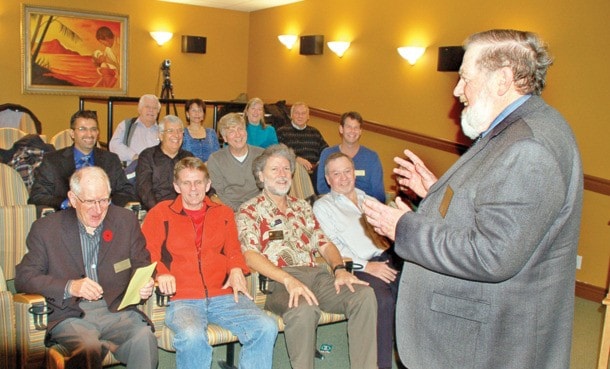Brett BonderudBlack Press
Flushed cheeks, sweaty palms, dry mouth and wobbly knees often accompany someone who’s about to speak in front of a crowd.
Whether it’s a social or work function, many people view public speaking as an unfortunate obligation, and wish later they never have to do it again.
But for people who need to speak in public – those in sales, management or the self-employed – or others who desperately want to overcome their fears, there is Toastmasters.
The organization’s aim is helping people overcome their fear of public speaking.
“The greatest thing is to see people go from knocked-kneed to pro-speaker after completing Toastmasters’ speech program and leadership courses,” Sandy VanDeKinder, Toastmasters’ area 63 (White Rock/South Surrey) governor, said.
The organization’s been around for 87 years and currently has 270,000 members in 106 countries around the world.
VanDeKinder said members come from all walks of life and different age ranges.
According to Toastmasters International, 30 per cent of their members earn $100,000 or more per year. Fifty-two per cent are female, with about 70 per cent being between the ages of 35 and 49.
Toastmasters members have included actors (Leonard Nimoy), astronauts (James Lovell) and politicians (former B.C. premier Bill Bennett).
White Rock/South Surrey’s six clubs comprise 114 members, ranging in age from late 20s to 86 years old. Members include a retired school principal, a City of Surrey employee and others in professions where they oversee staff.
Toastmasters was founded by YMCA educational director Ralph C. Smedley in a YMCA basement in Santa Ana, California in 1924.
Smedley thought members needed “training in the art of public speaking and in presiding over meetings” in a supportive, informal atmosphere.
His approach caught on, and soon clubs sprang up throughout North America.
By 1930, various clubs had formed a federation to help co-ordinate activities and provide a standard program. Toastmasters became Toastmasters International after a New Westminster, B.C. club joined the federation.
Anyone interested in Toastmasters can search the organization’s website, find a club and pop in to any one of them to witness members in action –making speeches and refining techniques.
A newbie can come to three meetings without becoming a member. If they want, they can go to a different club, three times, for as long as there are clubs to visit. Knock four times however, and they’re in membership territory.
Once a member, be prepared to speak. The good thing is it can be on anything. A first-timer should be prepared to do two minutes in front a crowd.
It’s an easy room though.
Toastmasters is about support, VanDeKinder said.
“The sandwich method,” she noted, where members are propped up emotionally and physically if need be, to help them overcome their public speaking fears.
“I didn’t want to get up and speak,” VanDeKinder said, recalling her first time.
She joined because of her work. She was reluctant to speak in front of people, but her job required her to do so.
“It’s a double-edged sword.”
Because of her Toastmasters’ involvement, she got better at her job as director of a senior’s society. She’s been a member since 2009 and area governor since July of this year.
Toastmasters is divided into two sections – leadership and communication.
Leadership means assuming different roles within the organization like that of club grammarian or “ah-counter” – too many ums, ers and ahs, and the audience may lose interest.
The communication component involves various speech projects designed to elevate members’ confidence and speaking power through eliminating awkward pauses.
The speech projects build up speakers’ confidence slowly, with topics members will be interested in. The aim is to build confidence within a nurturing environment – the “sandwich.”
A good speech appeals to an audience’s interest by connecting emotionally, VanDeKinder noted. The speaker should be animated and full of energy and, if possible, funny – a trait that often wins competitions.
“The funny guy always gets it,” she said.
But regardless of what attributes and expertise participants bring to Toastmasters, they don’t necessarily have to be funny. They just have to be willing.
